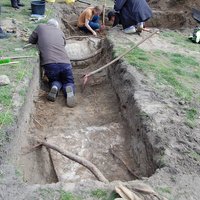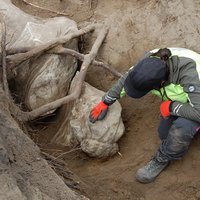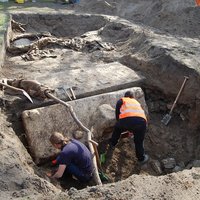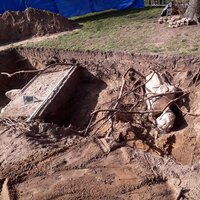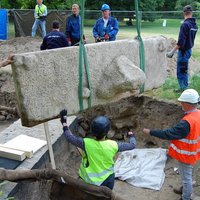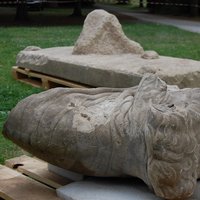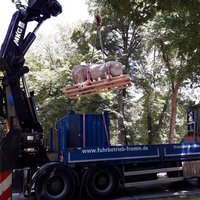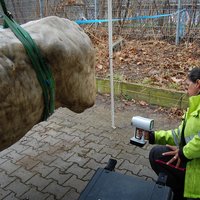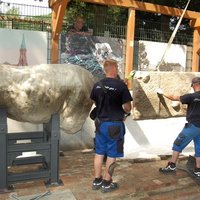The “White Bull” from Humboldthain
The “White Bull”, created between 1897 and 1900 by the Rixdorf sculptor Ernst Moritz Geyger (1861–1941), was erected in Volkspark Humboldthain in Berlin-Wedding during the imperial period in 1902. The sculpture, made of white marble, was located in the middle of the park on a small hill by the large meadow where a small rivulet flowed into a pond. It was once a popular meeting place in the Volkspark, especially among lovers.
Due to a recent article in the Weddinger Kiezblatt brunnen-Magazin, Dietmar Arnold, chairman of the association, became aware of the sculpture and started researching it with archaeologist Claudia Melisch. Until then, it had been assumed that it was made of bronze and melted down for armament production during the Second World War. Hopes that the marble bull had been buried on site to protect it from bombs were dashed when a photo from 1946 was discovered in the Bildarchiv Preußischer Kulturbesitz (bpk) showing the destroyed sculpture still in its old location. On another photo it was then noted: “Buried on site”.
Therefore, at the beginning of 2022, an excavation permit to search for the bull was applied for at the Mitte district office, in coordination with the Berlin State Monuments Office. In February, geophysical surveys were carried out in the target area by Büro für Geophysik Lorenz, which revealed promising signals in the ground. During the subsequent exploratory excavations, the sculpture was rediscovered and completely uncovered from 11th to 13th April 2022 under the direction of Claudia Melisch. Not deep under the turf, both the base on which the bull was originally placed and the torso of the artwork, the broken-off head as well as fragments of the sculpture’s legs and ears were discovered.
On 13th June, we were able to successfully recover and transfer the three large fragments (torso, plinth, and head of the sculpture) together with archaeologists, restorers, the Altendorff transport company, and other helpers. Unfortunately, no further fragments of the sculpture were found during the subsequent excavation. It was hoped to find the snout and further parts of the legs. The recovered parts will now be temporarily protected and stored in a safe place for restoration measures and 3D measurements.
The initial wish to completely restore the original sculpture and make it visible and accessible to the public again in its original location could no longer be fulfilled due to the state of weathering and the weight alone of the fragments, and the disproportionately high costs involved. In February 2023, the torso, head, and plinth of the “White Bull” were therefore scanned (3D laser scan) and the necessary parts of the torso were moulded at the depot of the Straßen- und Grünflächenamt Mitte (Volkspark Humboldthain). Using the results of the moulding, the idea of creating a replica of the bull and installing it in the original location is to be further pursued by the association.
The unique original fragments of the marble sculpture were placed in the “Archaeological Window” at the edge of Humboldthain on 21st June 2023 after being transported a short way by the Karl Altendorff company, where they have now found their final place of installation and exhibition - supported by a filigree metal substructure by the Dembowski blacksmiths to protect them from the weather and vandalism.
We would like to sincerely thank the Mitte district office of Berlin for the uncomplicated and fast approval procedures to realise this project in the Volkspark for our district!
Donations:
Anyone who would like to continue to support our project can do so with a donation under the intended use “Reconstruction of the White Bull”.
Contemporary witnesses:
In connection with the rediscovery of the “White Bull”, we are looking for contemporary witnesses who still have photos, memories, or information from the period 1933 to 1950. Please contact our office by phone at (030) 49 91 05-17 or by email: buero(at)berliner-unterwelten.de.
Addendum:
The current find met with huge media interest. Unfortunately, some print media have turned the find into the “Hitler bull” and the sculptor Geyger into the “Hitler sculptor”. This does not correspond to the historical facts at all and must therefore be refuted:
Ernst-Moritz Geyger was born on 9th November 1861 in Rixdorf near Berlin and was neither a “Hitler sculptor” nor Adolf Hitler’s favourite sculptor. Geyger was never on a par with Nazi sculptors such as Arno Breker and Josef Thorak. He lived and worked in the Medici Villa Marignolle near Florence, Italy from 1895, had a student studio in Florence and maintained a second studio in Berlin. At the turn of the century, he returned to Berlin for four years and then again from 1918 to 1927 as professor of the master studio for graphic art at the Berlin Academy of Arts. From 1927, his permanent residence was in Florence. He was 75 years old when Hitler awarded him an honorary degree in 1936. Geyger died in Florence on 29th December 1941. He was awarded the Goethe Medal for Art and Science a few days before his death. The bull sculpture was erected as early as 1902, when Hitler was a 13-year-old teenager.
instagram takipçi satın al - instagram takipçi satın al mobil ödeme - takipçi satın al
bahis siteleri - deneme bonusu - casino siteleri
bahis siteleri - kaçak bahis - canlı bahis



